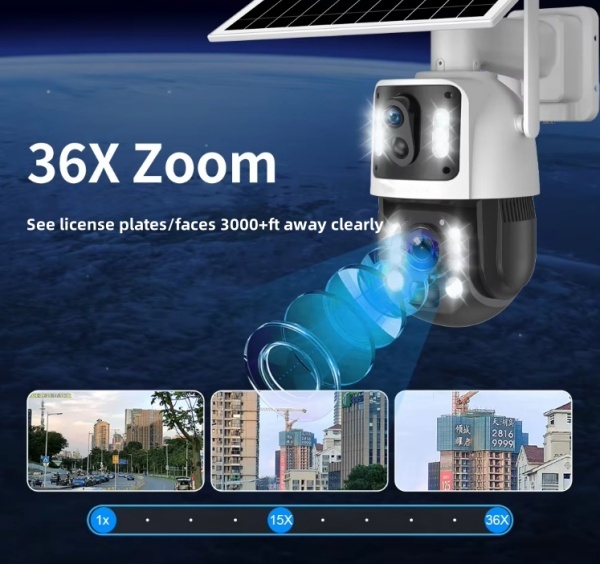Solar Camera Winter Performance: An Engineer’s Guide to Cold Weather Reliability
As a B2B partner, your biggest concern is reliability. When you sell, install, or deploy a security solution, your reputation is on the line. One of the most common and costly points of failure for outdoor security is winter. A customer calls: “The camera you installed went offline, and it’s -15°C outside.” This single pain point can erode trust and lead to expensive service calls. The question is no longer *if* a solar security camera works, but *how well* it performs when temperatures plummet.
For over a decade, we’ve engineered solutions specifically to address this challenge. The problem isn’t just about using a “good” battery; it’s about a holistically designed system where the solar panel, Battery Management System (BMS), and power consumption logic work in concert. Understanding how cold affects these components is the first step to choosing a product that won’t fail your customers or your business during the harshest months.
The Science of Cold: How Temperature Impacts Your System
To build a reliable winter-proof camera, we must first respect the laws of physics and chemistry. Low temperatures fundamentally alter the performance of the two most critical components: the battery and the solar panel. Ignoring these principles is a recipe for system failure.
The battery, typically Lithium-ion (Li-ion), is the heart of the system. Think of it as a chemical engine. In cold weather, the electrolyte inside the battery becomes more viscous, slowing down the movement of lithium ions between the anode and cathode. This slowdown increases the battery’s internal resistance. The practical result? The battery’s voltage drops under load, and its effective capacity is significantly reduced. More critically, charging a frozen Li-ion battery can cause permanent damage through a process called lithium plating, which can lead to a catastrophic cell failure.
Solar panels, on the other hand, have a counterintuitive relationship with cold. The photovoltaic cells are actually *more* efficient at converting sunlight into electricity in colder temperatures. However, this benefit is often completely negated by real-world winter conditions: shorter daylight hours, a lower sun angle in the sky (reducing irradiance), and the high probability of the panel being covered by snow, frost, or ice. The primary challenge for solar panels isn’t the cold itself, but the reduced availability of light.
The Battery Dilemma: Why the BMS is Your First Line of Defense
Many manufacturers will simply list a battery’s capacity (e.g., 20Ah) without detailing its cold-weather protections. This is a critical omission. The single most important component for winter survival is the Battery Management System (BMS). A basic BMS provides simple over-charge and over-discharge protection. An advanced, winter-ready BMS is far more intelligent.
Our engineering philosophy at UBOXCAM is that the BMS must act as the system’s brain. It constantly monitors cell temperature. When the temperature drops below a safe charging threshold (typically 0°C or 32°F), a smart BMS will completely halt the charging process, even if the solar panel is producing power. This prevents the irreversible damage of lithium plating. It protects the battery’s lifespan and, more importantly, ensures safety.
For truly demanding environments, such as those in Canada or the northern United States, we integrate more advanced solutions. Some of our custom models incorporate low-temperature battery cells designed to operate safely down to -20°C (-4°F) or even heating elements that use a small amount of solar energy to warm the battery pack to a safe operating temperature before commencing a charge. This ensures the camera remains operational and can recharge even on a cold, sunny day.
Core Technology Comparison: Battery Chemistries in Cold Weather
The choice of battery chemistry is a crucial design decision involving trade-offs between cost, energy density, and temperature resilience. Here’s how common options stack up for B2B applications:
| Feature | Standard Lithium-Ion (NMC/NCA) | Lithium Iron Phosphate (LiFePO4) | Low-Temp Li-Ion |
|---|---|---|---|
| Energy Density | High | Moderate | High |
| Low-Temp Charging | Poor (Risks damage below 0°C) | Poor (Risks damage below 0°C) | Good (Specialized electrolyte allows charging down to -20°C) |
| Low-Temp Discharging | Moderate (Capacity loss) | Good (Less capacity loss than Li-ion) | Excellent (Maintains higher capacity) |
| Cycle Life | Good (500-1000 cycles) | Excellent (2000+ cycles) | Good (500-1000 cycles) |
| Best For | General use in moderate climates. | Applications requiring very long service life in moderate climates. | Critical infrastructure and B2B deployments in cold climates. |
Solar Panels in Winter: Optimizing for Low-Light Conditions
As mentioned, solar panels are not the weak link in the cold, but their input is. A system designed for summer in California will fail in a German winter. The key is not just the panel’s peak wattage but a comprehensive energy balance calculation. For our partners deploying in northern latitudes, we always recommend or build systems with oversized solar panels.
A panel that is 50-100% larger than what’s needed for summer provides a critical buffer. On a short, overcast winter day, it can still generate enough power to offset the camera’s nightly consumption. Furthermore, the physical mounting is crucial. We advise our installation partners to mount panels at a steeper angle in winter-prone regions. This helps snow slide off more easily and positions the panel more directly towards the low winter sun. For more information on system balance, you can explore our analysis of 4G vs. WiFi solar cameras, as connectivity choice also impacts power draw.
Troubleshooting & Maximizing Winter Uptime: An Engineer’s Q&A
Here are solutions to the most common winter-related issues we help our B2B clients solve.
- Problem: My camera goes offline every night when it gets very cold.
Solution: This is a classic symptom of the battery’s voltage dropping below the BMS’s low-voltage cutoff threshold. The cold increases internal resistance, causing the voltage to sag under the load of the camera and its IR lights. The solution is a system with a battery and BMS engineered for low temperatures or a larger battery/panel combination to ensure a higher state of charge before nightfall. - Problem: The camera app shows it isn’t charging, even on a sunny day.
Solution: This is likely your smart BMS protecting the battery. If the internal battery temperature is below freezing, the BMS will prevent charging to avoid damage. The system will resume charging once the sun warms the camera housing and battery pack above 0°C. This is a sign of a well-designed, reliable system. - Problem: Snow is constantly covering my solar panel.
Solution: Besides periodic cleaning, the best preventative measure is a steep mounting angle (45-60 degrees). For critical sites, like our construction site security cameras, we can also discuss options like hydrophobic coatings that help shed snow and ice.
Choosing a Supplier: Your B2B Checklist for Cold-Weather Success
When evaluating a solar security camera supplier for your business, move beyond the basic specifications. Ask the hard questions to ensure you’re getting a truly all-season solution.
- Transparent Temperature Ratings: Does the manufacturer clearly state the operating *and* charging temperature ranges? Look for specifics, not vague terms like “all-weather.”
- BMS Technology: Ask about the BMS. Does it include low-temperature charging protection? Is it a feature they can explain in detail? This demonstrates true engineering depth.

- System Customization: Can the supplier adjust the solar panel and battery size based on the geographic location of the deployment? A one-size-fits-all approach is a red flag. At UBOXCAM, this customization is central to our B2B service.
- Proven Track Record: Ask for case studies or deployment examples in climates similar to yours. Experience is non-negotiable. Our solutions are trusted in demanding environments, from smart agriculture fields to remote infrastructure sites.
Your Partner for All-Season Reliability
Winter performance is not an add-on; it’s a core design principle. For wholesalers, installers, and brands, selling a camera that fails in the cold is a direct path to customer dissatisfaction and margin erosion. The key lies in a balanced system where an advanced BMS, appropriate battery technology, and adequately sized solar panels work together to defy the elements.
Don’t let winter be a blind spot in your security offerings. Choosing an engineering-focused partner who understands these nuances is the best way to protect your investment and your reputation. Contact the UBOXCAM engineering team today to discuss your specific requirements for cold-climate deployments and discover how our customizable, factory-direct solutions ensure year-round performance and profitability for your business.

